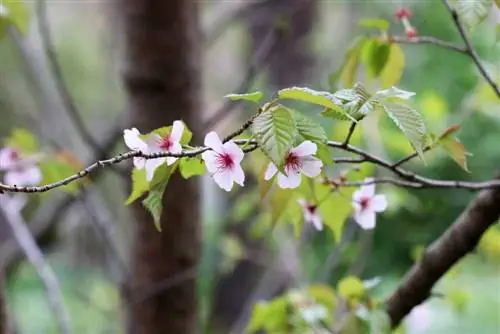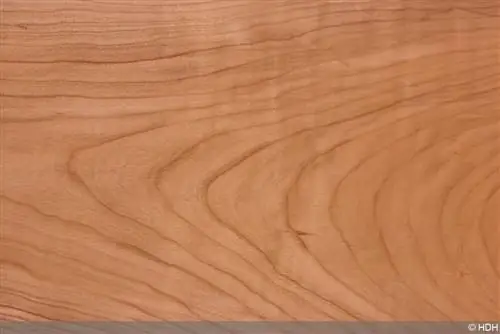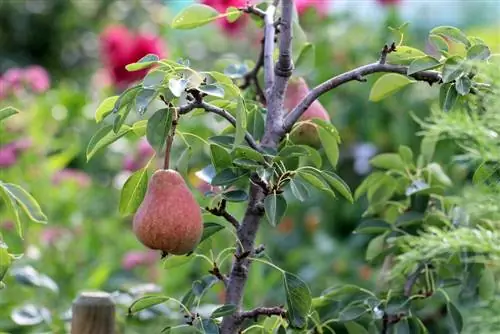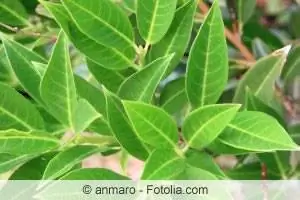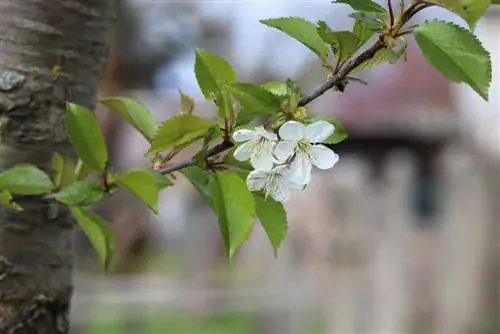- Author admin [email protected].
- Public 2024-01-31 11:14.
- Last modified 2025-01-24 12:45.
Anyone who has a Kuril cherry will be provided with plenty of color and can forget the dreary winter time from March onwards. Its numerous flowers are first pink then white. The foliage that follows develops a rich green color and then shines a striking orange-red in autumn. Thanks to its compact size, this ornamental cherry also fits into small front gardens. She is happy with little care and thrives almost on the side.
Growth and flowering
The Kuril cherry, bot. Prunus kurilensis is a small ornamental tree that was originally native to Asia. It grows to around two meters high and just as wide. Thanks to its strong branching, this type of cherry resembles a shrub. From April onwards, the tree blooms with numerous white to purple flowers, which later develop into small red cherries. These are edible, but not particularly tasty for us humans. However, the birds love these red fruits. Popular varieties are 'Brilliant' and 'Ruby'.
Tip:
The Kuril cherry is well suited for a Japanese garden due to its growth.
Location
Prunus kurilensis has certain requirements regarding the ideal location, although minor deviations from it are certainly tolerated.
- needs a lot of heat and light
- It grows optimally in a sunny spot
- then abundant flowers will be formed
- It also thrives in a partially shaded location
- In purely shady places it lacks warmth and light
Due to its size, the Kuril cherry is predestined for the middle row of plants. Larger trees can grow behind them, while short perennials in front of them can be shown to their best advantage. But this colorful tree also cuts a fine figure in a location where it stands as a solitary plant.
Floor
The dwarf cherry doesn't like waterlogging. A heavy soil that does not allow water to percolate well is not suitable for them. Fortunately, this can be easily loosened up with gravel or sand so that it can still provide the cherry with the optimal conditions.
- sandy, well-drained soil
- neutral pH value
- well-loosened soil facilitates root growth
- enrich lean soil with some compost
Planting time
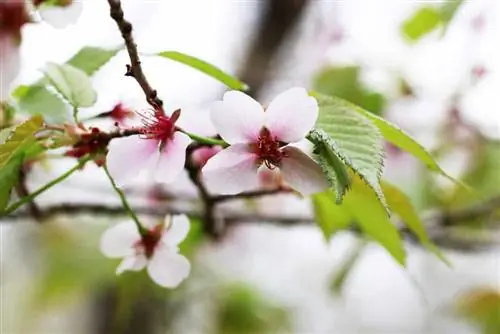
The leafless period from autumn is the ideal planting time for deciduous trees, including the Kuril cherry.
- plant from October to March
- Autumn and spring usually offer optimal temperatures
- It can be too cold to plant in winter
- Soil must be frost-free
This planting time should definitely be adhered to for bare-root trees. Kuril cherries, which are sold in containers all year round, can also be planted all year round. But here too, the leaf-free period is best. At least hot and sunny days should be avoided if possible.
Planting out
Planting a Kuril cherry in the garden is done as follows:
- Water the small tree well by placing it in the water for about 30 minutes.
- In the meantime, dig the planting hole. It should be at least twice as big as the pot ball.
- Take the tree out of the container and place it in the prepared planting hole.
- Keep the Kuril cherry upright and fill the gap with good potting soil.
- Tread the soil lightly.
- Water the cherry well.
- Water the young ornamental tree regularly in the first year, as rooting still needs time. Particularly if the planting took place during a warm weather period, care must be taken to ensure sufficient water supply.
Tip:
The excavated garden soil can also be used instead of plant soil. Since the tree needs a lot of nutrients at the beginning, it should be enriched with compost or fertilizer beforehand.
Container planting
Since this beautiful tree remains relatively small even when fully grown, it is ideal for planting in large containers. If necessary, the compact shape can also be kept smaller through targeted cutting measures. However, keeping it in a bucket requires a little more care:
- needs to be watered more often
- regular fertilizer applications necessary
- repot after three years
- alternatively rejuvenate the root ball
- if applicable provide winter quarters
Tip:
In a pot, the Kuril cherry can be combined well with other smaller flowers. On the one hand, this looks good, on the other hand, it shades the root area and prevents it from drying out.
Fertilize
Trees inherently have a good supply of nutrients. If they are given too much artificial fertilizer, they can quickly become unbalanced.
- Giving compost when planting out
- otherwise fertilize very sparingly
- A little phosphorus fertilizer before flowering promotes flower formation
Pouring
Watering the Kuril cherry depends on the weather and is based on the actual water requirement.
- >watering required on warm and dry days
- >water again when the top layer of soil is dry
- >young trees and potted plants need to be watered more often
Note:
This dwarf cherry also tolerates water containing lime.
Cutting
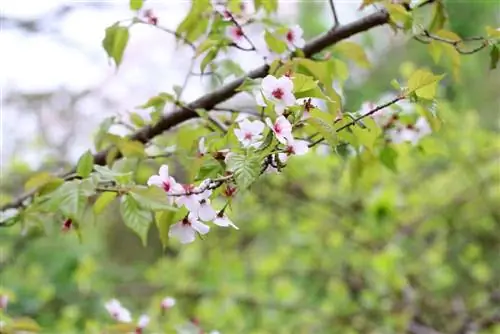
Kurilen cherry grows very slowly and branches out beautifully. Cutting is not necessary, but can be done if necessary.
- only cut from the third year onwards
- ideal is spring before new growth
- Throw out solitary plants carefully
- shorten branches that are too long after flowering
Propagation of cuttings
The dwarf cherry can in principle be propagated via cuttings. However, this method requires a lot of luck. This type of propagation is rarely successful for laypeople and is therefore not recommended. If you still want to try it, you should note the following:
- Autumn is the right time
- Use sand substrate
- Choose a shoot with at least two eyes
- Place the pot with cuttings in the shade
- keep moist throughout
If the cutting has successfully rooted, it can be planted outdoors in spring.
Diseases and pests
A well-cared for Kuril cherry is safe from pests. Every now and then the Prunus can be attacked by the Monilla fungus. The fruits rot and show brownish spots. The usual cutting measures do not bring any improvement here. The fungal disease can only be combated permanently with fungicides.
Wintering
Prunus kurilensis copes well with the winter cold. It can survive up to -35 degrees without any damage.
- no special protective measures required outdoors
- Potted plants should overwinter in a cold but frost-free room
- Alternatively: wrap the pot with protective fleece
Note:
Potted plants do not tolerate strong sunlight in winter. They should therefore be placed in the shade.

